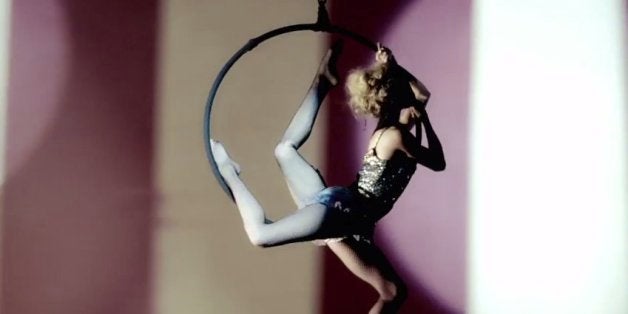
Ryan Murphy is afraid we'll all tune out season four of American Horror Story. Its just going to be "too scary" for us, he recently said.
He's not really afraid of this. What better way for a showrunner to promote a new season than to suggest that an audience who has hung on through murder houses, Nazis in 1950s asylums, and scenes of antebellum torture featuring Kathy Bates with a minotaur won't be able to handle what he has planned for us next.
It is true, however, that the new season has chosen to explore an outré moment in the history of horror. In fact, Freak Show draws us into one of the horrors of American history.
"The freak show," a colloquial term for what was known as the "penny museum" when serving as localized entertainment and later as the "sideshow" when it became part of the travelling circus, competed with blackface minstrelsy as America's most popular form of nineteenth century entertainment.
It was a stranger phenomenon than you might even imagine.
American freak shows have their origin in the 18th century with even older antecedents. English fairs long promoted various kinds of oddities as attractions while Enlightenment era anatomists kept and displayed "cabinets of curiosities." These collections included malformed fetuses kept in jars (familiar to American Horror Story fans who remember the opening credits of season one) and various fossils, at that time mostly unidentified.
The American freak show came into its own in the decades just before the civil war. P.T. Barnum fundamentally shaped the tradition. Barnum once proudly said that the title "prince of humbug" had been "first attributed to me by myself." But the American public never seemed to mind his marvelous frauds. In 1842, Barnum exhibited the body parts of a monkey and a fish taxidermied together and pronounced it "the Feejee mermaid." Crowds came in droves and the Mermaid went on tour.
Barnum did more than exhibit "marvels" and "wonders." He also presented people as monsters.
Some of the most famous "freak" acts of the 19th century premiered at Barnum's American Museum at the corner of Broadway and Anne in New York City. Many of these later joined "the Big Show," as Ringling Brothers and Barnum and Bailey Circus became known. His freaks included Chang and Eng, conjoined twins from Thailand and "General Tom Thumb," the famed English midget whose adult height never exceeded 25 inches. "Jo-Jo the Dog Faced Boy" proved a popular attraction. Suffering from a rare skin condition called hypertrichosis, Jo-Jo (whose real name was Fedor Jeftichew) received top billing from Barnum as " The MOST PRESTIGIOUS PARAGON OF ALL PRODIGIES."
The idea of people as exhibits, called "freaks" and sometimes "monsters," probably strikes you immediately as ethically problematic. It's important to remember that the penny museum and the sideshow first emerged in an America where the slave system regularly exhibited human beings on the auction block. Sideshows into the 20th century almost always had a connection to America's obsession with race. In fact, they became theaters of racial difference.
The "ethnological congresses" common to travelling circuses are examples of this phenomenon. These exhibits presented "exotic cultures" right alongside wild animals, physical curiosities and people with various disabilities and abnormalities. After seeing Jo Jo and Chang and Eng, American audiences might look at "an authentic Japanese village" or see what was described as the "primitive" life of an African tribe. Large-scale versions of these frequently appeared as part of big city fairs and exhibitions, including the 1893 Chicago World's Fair.
What did people find so appealing about such spectacles? It seems that in a period when, not unlike our own, Americans worried over immigration and the meaning of "real America," sideshow exhibits offered the abnormal as a way to secure the boundaries of the normal. Ideas about race, especially as a new form of white supremacy emerged after the civil war, played a crucial role in this process.
The story of William Henry Johnson best illustrates how race figured into the freak show. In the 1860s, the Barnum's American Museum began to feature the mentally challenged African-American microcephalic, called a "pinhead" in sideshow lingo. Barnum had Johnson dressed in furs, encouraged him to act fierce and placed him in a setting that suggested he represented some kind of "missing link" in human evolution. In fact, Barnum billed Johnson as the "What is it?" and later as "the nondescript."
Despite nods to the alleged scientific importance of Johnson, whenever his keepers lectured to audiences about his "true story, they described him as both "a man-monkey" and a member of "an African tribe" they alleged had been discovered on the Gambia River. In a bitter irony, Johnson was actually the son of former slaves, transformed now into a racist construction of primitivism.
Our popular culture is awash in monsters, so I don't really imagine season four of American Horror Story being too scary for audiences to handle. That is, unless Murphy and his crew investigate the real American horror story of race and difference in America. And, knowing this show, they just might.
You can read more about the real American freak in Monsters in America. You might also want to take a look at Robert Bogdan's Freak Show and Rachel Adams, Sideshow U.S.A. These are good reading companions as you settle in to Season 4 (and try to go back to sleep after your nightmares about Twisty the Clown).
